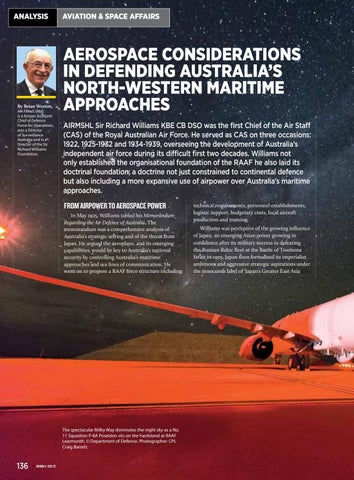ANALYSIS
By Brian Weston,
AM FRAeS (Rtd) is a former Assistant Chief of Defence Force for Operations, was a Director of Surveillance Australia and is a Director of the Sir Richard Williams Foundation.
AVIATION & SPACE AFFAIRS
AEROSPACE CONSIDERATIONS IN DEFENDING AUSTRALIA’S NORTH-WESTERN MARITIME APPROACHES AIRMSHL Sir Richard Williams KBE CB DSO was the first Chief of the Air Staff (CAS) of the Royal Australian Air Force. He served as CAS on three occasions: 1922, 1925-1932 and 1934-1939, overseeing the development of Australia’s independent air force during its difficult first two decades. Williams not only established the organisational foundation of the RAAF he also laid its doctrinal foundation; a doctrine not just constrained to continental defence but also including a more expansive use of airpower over Australia’s maritime approaches.
FROM AIRPOWER TO AEROSPACE POWER In May 1925, Williams tabled his Memorandum Regarding the Air Defence of Australia. The memorandum was a comprehensive analysis of Australia’s strategic setting and of the threat from Japan. He argued the aeroplane, and its emerging capabilities, would be key to Australia’s national security by controlling Australia’s maritime approaches and sea lines of communication. He went on to propose a RAAF force structure including
The spectacular Milky Way dominates the night sky as a No. 11 Squadron P-8A Poseidon sits on the hardstand at RAAF Learmonth. © Department of Defence. Photographer: CPL Craig Barrett.
136
EDITION 4 • 2021-22
technical requirements, personnel establishments, logistic support, budgetary costs, local aircraft production and training. Williams was perceptive of the growing influence of Japan, an emerging Asian power growing in confidence after its military success in defeating the Russian Baltic fleet at the Battle of Tsushima Strait in 1905. Japan soon formalised its imperialist ambitions and aggressive strategic aspirations under the innocuous label of ‘Japan’s Greater East Asia Co-
